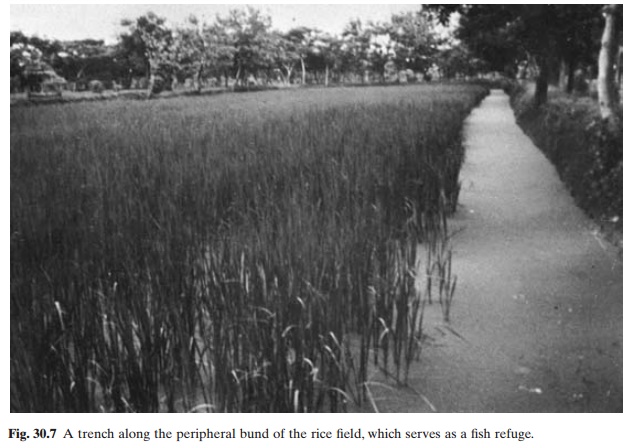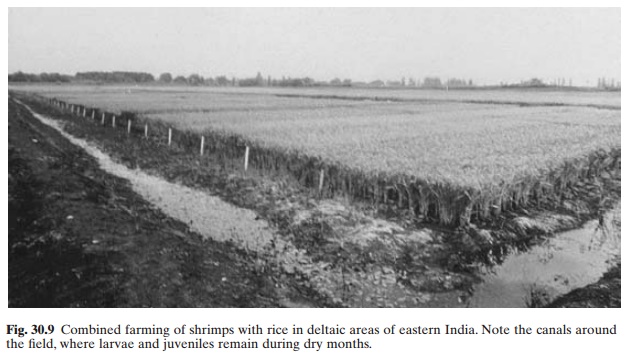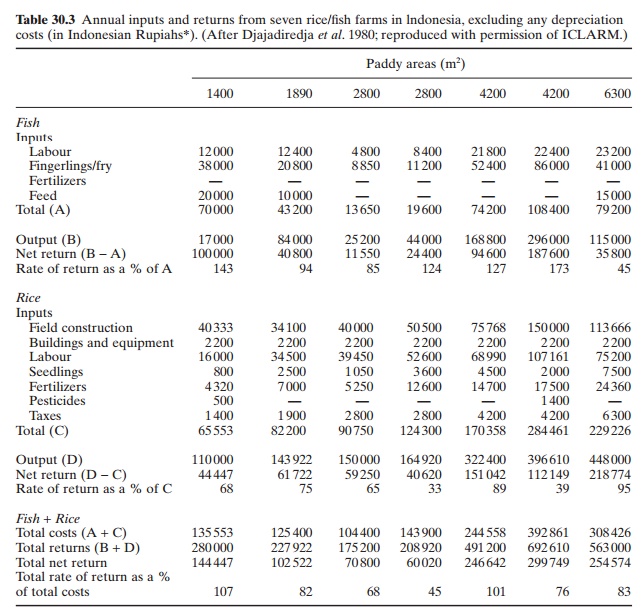Chapter: Aquaculture Principles and Practices: Integration of Aquaculture with Crop and Livestock Farming
Combined culture of rice and fish - Rice field aquaculture
Combined culture of rice and fish
When
combined culture of rich and fish is planned, some additional constructions
will be needed. As in the case of rotational culture, the bunds around the
field have to be strengthened and the height increased. Straw may be embedded
along the inside walls of the bunds to make them watertight. A height of
25–60cm is required, depending on the water level required and the species to
be cultured. Usually the inlets and outlets are provided with pipes and screens
to prevent escape of fish and ingress of undesirable animals. It is a common
practice to dig a series of trenches to serve as fish refuges when the water in
the field gets too cold or too warm, or when the water level in the rest of the
field has to be reduced (fig. 30.7). They may be built along the peripheries or
across the field. A width of 50cm and a depth of 30cm would normally be enough,
but for extreme temperature conditions deeper trenches (up to 90cm) are
recommended. Depending on the type of soil, a side slope of 30–45 degrees may
be necessary. It will also be useful to have a sump connected to the trenches
near the inlet to facilitate harvesting of the fish and provide additional
shelter during the cultivation period.

Although there are several species cropped from rice fields, the main species presently used in combined rice/fish culture in fresh waters are the common carp, tilapia, nilem carp (Osteochilus hasseltii), kissing gourami (Helostoma temmincki) and sepat siam (Trichogaster pectoralis) and less frequently the Java carp (Puntius gonionotus), snakehead (Channa) and catfish, (Clarias). Limited experimental work in India has shown the suitability of Indian carps for such integrated farming. As mentioned earlier, the use of the goldfish Carassius and the tench Tinca in Italy appearsto have died out now, largely because of changes in rice farming methods. In the extensive system of polyculture of shrimps and brackish-water species practised in the estuarine regions of the river Ganges in eastern India, all the locally important shrimps and prawns (Penaeus semisulcatus, Metapenaeus monoceros, M. brevicornis, Palaemon carcinus and P. rudis) and brackish-water fish (Mugil parsia, M. tade, Rhinomugil corsula, Lates calcarifer and Mystus gulio) are used.
The most
successful species in rice fields are those which can thrive in shallow waters
and tolerate fairly high turbidity and high temperatures. Since the duration of
culture is rather limited, they should have high growth rates and reach marketable
size in a few months.
The
literature on rice-field aquaculture shows that a variety of techniques and
stocking rates have been employed in different countries. As many of them are
presently not employed, because of declining interest or conflict in production
practices, it may not be of much use to summarize them here. For example, the
very intensive system of common carp farming in rice fields developed in Japan
is not practised now, if at all, on any significant scale. One of the few
countries where it still exists on a wide scale is Indonesia, where through
government legislation it has been possible to restrict the types of pesticides
that can be used in rice fields. Another factor that has promoted the continued
practice of ricefield fish culture is the acceptance of small fish by
Indonesian consumers.
Basically,
the methods of culture adopted in Indonesia are for production of either
fingerlings or fish for consumption. Monoculture of common carp is more popular
than polyculture. Tilapia, kissing gourami, nilem carp and Java carp form only
minor components in species combinations. Many farmers continue to use local
varieties of rice, which take up to sixmonths to be harvested.This makes it
possible to have a longer period for fish culture and to grow more than one
crop per year. Fertilizers are used in the preparation of the rice fields.
Although organic manures are generally preferred in this type of integrated
farming, most farmers at present also use chemical fertilizers. A higher dose
of fertilizer, sometimes twice as much as normal, is used when fish culture is
combined with rice farming. Normally an increase in fertilizer of about 50% is
recommended.As excessive use of fertilizers may reduce rice yields due to
lodging and more severe attacks by pests, it is recommended that nitrogen
fertilizers should be applied in split doses and incorporated into the soil to
reduce nitrogen losses.

In
general, fish are stocked no earlier than five days after the transplantation
of rice seedlings, to give enough time for the seedlings to root properly. It
is recommended that stocking should be done only after 10 days if fry are used,
and in the case of fingerlings about three weeks after transplantation of rice
(fig. 30.8). The rate of stocking varies considerably, depending on species and
the size or age of the fry or fingerlings used. According to recent records,
when small fry are stocked for rearing to fingerling size, 2.2–7.6kg per ha of
fry are stocked. If the duration of culture is one month, 6.5–15kg per ha of
fingerlings can be harvested. When larger fry or fingerlings are stocked and
reared to consumption size, a yield of about 100kg/ha after two or three months
has been reported. This is a comparatively low production, but is probably due
to lack of any supplementary feeding and less intensive management. The yield
per ha is generally higher when fish are grown alone in the rice fields as a
rotational crop. In Thailand, a yield of 210–250kg per ha is obtained when
common carp are reared for about six months with supplementary feeding. When
advanced fingerlings are held over in ponds or reservoirs after the rice
harvest and reintroduced in the field for a second period of rearing with the
rice crop, much higher yields of up to 1800kg/ha per year have been reported
from Japan. In Taiwan, with monoculture of tilapia, and in Madagascar, with
monoculture of carp, yields of 200–250kg/ha per year are reported.

In the culture of brackish-water shrimps and fish in rice fields in deltaic areas of India, the stocking
rate is not regulated, but the larvae and juveniles which gain access at the
end of winter remain in the canal system (0.6–1.5m deep) which runs all round
the field or part of it. The water level in the canals is maintained at about
30cm below the level of the field (fig. 30.9). The fish grow in the canals up
to about June, when the flow of tidal water into the canal is stopped. The
fields are fertilized with organic manure and planted with a salt-resistant
variety of rice seedlings in about July. During the rainy season, rainwater
floods the fields and the canals and then the shrimps and fish migrate to the
rice-growing area and forage among the rice. By about October or November, when
the water level in the field goes down, the fish and shrimps move back into the
canal. Partial harvesting may start at this time, but the final harvest
coincides with the rice harvest. The estimated production of shrimps and fish
is about 100–200kg/ha per year.
Reliable economic evaluations of the effect of such combined farming on rice yields are not readily available. There is some reduction in the area available for rice cultivation because of the canals, trenches and sumps which are constructed as fish refuges, but it is believed that this is compensated for by the beneficial effects of the fish on rice production and the overall income derived by the farmer. Rice seedlings are planted with a distance of about 20cm between rows and 15 or 20cm between plants, in Asian countries. This allows enough space for the movement of fish and so there is no need to reduce the number of seedlings planted to make room for the fish. It has been suggested that even more space can be made available for fish movement by increasing the distance between rows to 25–30cm and reducing the distance between plants, without affecting the number of seedlings planted and the yield of rice (Singh et al., 1980).
Table
30.3 presents cost and return data on seven rice/fish farms in Indonesia, to
illustrate the relationship between inputs and outputs in this type of farming.
As is obvious, the economics are site-specific and highly variable.

When fish
have to be grown to a larger size than is possible in the limited duration of a
rice crop, the farm should have additional holding or rearing facilities for
the period between rice harvest and the planting of new seedlings. The use of
the canal system for the culture of brackish-water shrimps and fish in India,
described earlier, is one type of facility that would enable prolonged culture.
The procedure of culture of one- and two-year-old carp in rice fields described
by Kuronuma (1954) involves rearing harvested fingerlings from rice fields in
separate ponds and later in wintering ponds, before stocking them in the rice
fields for a further period of growth along with the rice. With adequate feeding
the carp can be grown to the required size. Obviously, this involves higher
inputs, including labour.
Related Topics